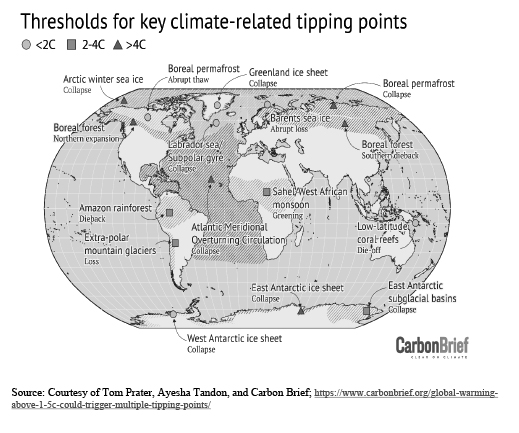Climate scientists lose sleep over tipping points, temperature thresholds when crossed initiate self-sustaining, irreversible, and massively-destructive changes in natural systems, such as glaciers and forests. Countless living things will face untimely and unnatural deaths if these systems collapse.
New research (David Armstron McKay, 2022) on tipping points has scientists losing more sleep. There are 16 natural systems (“tipping elements”) vulnerable to heat-driven collapse. While most tipping points lie in the future, several are staring us in the face. Indeed, at 1.2 degrees Celsius (2.2 degrees Fahrenheit) — our current global temperature increase — we may have already passed the tipping points for the Greenland and West Antarctic ice sheets. At 1.5 degrees C
(2.7 F), irreversible disintegration of these giants becomes likely. However, planet earth is on a trajectory to reach 2.5 degrees C (4.5 F). Then, the likely becomes almost certain.
Greenland contributed to one-fourth of sea level rise in 2014 and its melting rate is accelerating. It’s not helping that rain can now fall even on Greenland’s tallest glacier (10,500 feet). The amount of the first rainfall (Aug. 14, 2021) is unknown, however. Scientists brought no rainwater gauges because it doesn’t rain on glaciers, does it?
Ultra-conservative predictions have Greenland alone contributing about a foot of sea level rise by 2100; more than two feet is possible. Hansen and many others, for example, are finding much faster rates of ice melt than those predicted by climate models and cite maximum increases of eight or more feet when all sources of sea level rise are considered.
Sources such as Thwaites, Antarctica’s “doomsday glacier,” is “losing its grip.” Extending 70 miles along Antarctica’s coast, Thwaites is the longest glacier in the world. Most worrisome, its grounding point — where its ice sheet is anchored to bed rock — lies underwater. Presently, increased freshwater melt is depositing a layer of cold, light water over the surface of adjacent ocean. This layer traps warmer, heavier, upwelling saltwater at depths where it can accelerate ice sheet melt from below. As a result, Thwaites is “breaking, thinning, melting, and in some cases collapsing …” (Ted Scambos, 2022).
Harold Wanless, earth scientist at the University of Miami, spells out what accelerating glacial melt means for Florida. With only two feet of sea level rise, almost 40 percent of Miami-Dade County, seventh most populous county in the U.S., ends up under water, an inconvenient fact for Florida boosters. There are many other inconvenient facts. For example, in South Miami, where two-thirds of homes rely on septic systems, heavy rains now result in raw sewage backing up into some sinks and bathtubs. And Florida homes lying fewer than six feet above current sea levels can no longer get a 30-year mortgage.
So, how have Florida power brokers reacted?
“Scientific evidence shows that the party is over … The dance floors, bars, bathrooms, and parking lots are being swallowed by the sea. Still, the booze is flowing, the dance floors are packed, and the bank accounts of the developers, lobbyists, and their respective politicians are growing fatter at record rates” (Dahr Jamail, The End of Ice, page 109).
Jamail described 2019; Hurricane Ian — an inflection point? — describes 2022. Will Ian mark the beginning disintegration of a human-made system: The Florida real estate market (Christopher Flavelle, 2022)? Has Florida’s party finally become impossible to sustain?
References
Carrington, Damian. 2022 (Aug 29). Major sea-level rise caused by melting of Greenland ice cap is ‘now inevitable’; https://www.theguardian.com/environment/2022/aug/29/major-sea-level-rise-caused-by-melting-of-greenland-ice-cap-is-now-inevitable-27cm-climate
Flavelle, Christopher. 2022 (Oct 13). Why Ian May Push Florida Real Estate Out of Reach for All but the Super Rich. New York Times; https://www.nytimes.com/2022/10/13/climate/florida-real-estate-hurricane-ian.html
Hansen, James, et al. 2016. Ice melt, sea level rise and superstorms: The threat of irreparable harm. Columbia University; http://www.columbia.edu/~jeh1/mailings/2016/20160322_IrreparableHarm.pdf
Jamail, Dahr. The End of Ice. New York: The New Press.
McKay, David Armstrong, et al. 2022 (Sep 9). Exceeding 1.5°C global warming could trigger multiple climate tipping points. Science; https://www.science.org/doi/10.1126/science.abn7950
Scambos, Ted. 2022 (Jun 7). Ice world: Antarctica’s riskiest glacier is under assault from below and losing its grip. The Conversation; https://theconversation.com/ice-world-antarcticas-riskiest-glacier-is-under-assault-from-below-and-losing-its-grip-178828



1 comment for “Heat waves — in red & black | Danger zone: Will Greenland, West Antarctic ice sheets collapse?”